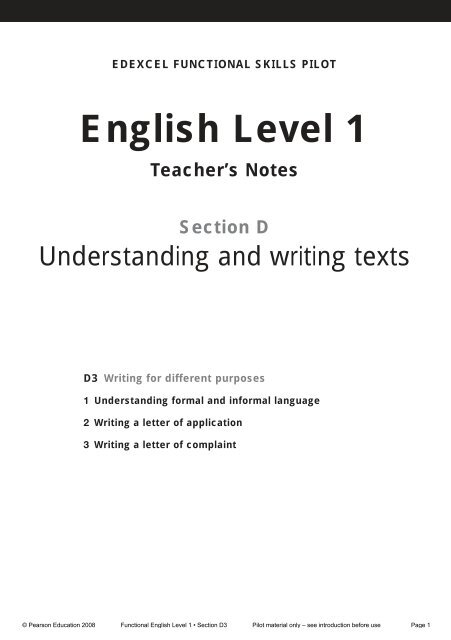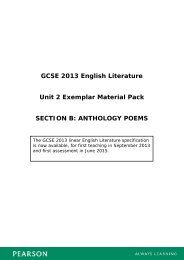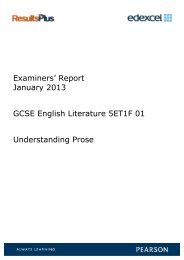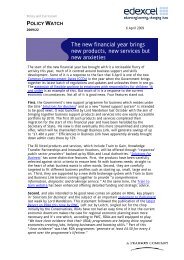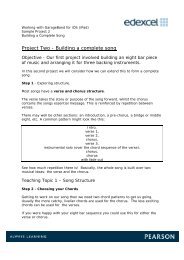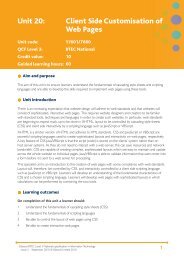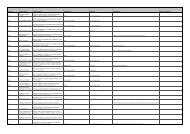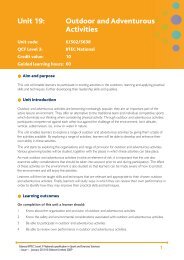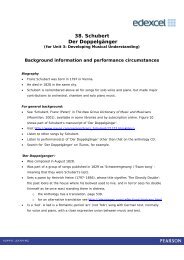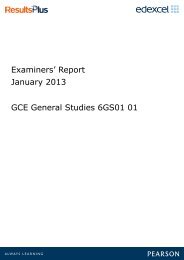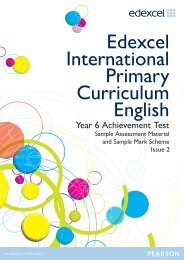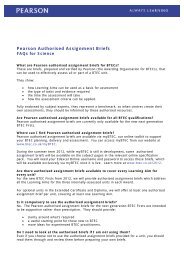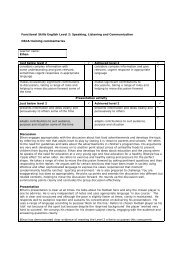English Level 1 - Edexcel
English Level 1 - Edexcel
English Level 1 - Edexcel
You also want an ePaper? Increase the reach of your titles
YUMPU automatically turns print PDFs into web optimized ePapers that Google loves.
Working with fractions, decimals and percentages 2<br />
EDEXCEL FUNCTIONAL SKILLS PILOT<br />
<strong>English</strong> <strong>Level</strong> 1<br />
Teacher’s Notes<br />
Section D<br />
Understanding and writing texts<br />
D3 Writing for different purposes<br />
1 Understanding formal and informal language<br />
2 Writing a letter of application<br />
3 Writing a letter of complaint<br />
© Pearson Education 2008 Functional <strong>English</strong> <strong>Level</strong> 1 • Section D3 Pilot material only – see introduction before use Page 1
Skills Standard Coverage and Range Learner Unit<br />
3 Writing<br />
EDEXCEL FUNCTIONAL SKILLS: INTErIm SUppOrT mATErIAL<br />
<strong>English</strong> <strong>Level</strong> 1<br />
Geoff Barton, Clare Constant, Kim Richardson, Keith Washington<br />
Section D: Understanding and writing texts<br />
D3: Writing for different purposes<br />
Use these free pilot resources to help build your learners’ skill base<br />
We are delighted to continue to make available our free pilot learner resources and teacher notes, to help teach the skills<br />
learners need to pass <strong>Edexcel</strong> FS <strong>English</strong>, <strong>Level</strong> 1.<br />
But use the accredited exam material and other resources to prepare them for the real assessment<br />
We developed these materials for the pilot assessment and standards and have now matched them to the final<br />
specification in the table below. They’ll be a useful interim measure to get you started but the assessment guidance<br />
should no longer be used and you should make sure you use the accredited assessments to prepare your learners for the<br />
actual assessment.<br />
New resources available for further support<br />
We’re also making available new learner and teacher resources that are completely matched to the final specification and<br />
assessment – and also providing access to banks of the actual live papers as these become available. We recommend that<br />
you switch to using these as they become available.<br />
Coverage of accredited specification and standards<br />
The table below shows the match of the accredited specification to the unit of pilot resources. This table supersedes the<br />
pilot table within the teacher notes.<br />
Write a range of texts to<br />
communicate information, ideas<br />
and opinions, using formats and<br />
styles suitable for their purpose and<br />
audience In more than one type of text<br />
3.3 Use language, format and<br />
structure suitable for purpose<br />
and audience<br />
3.3 Use language, format and<br />
structure suitable for purpose<br />
and audience<br />
3.5 Ensure written work includes<br />
generally accurate punctuation<br />
and spelling and that meaning is<br />
clear<br />
Published by Pearson Education, Edinburgh Gate, Harlow CM20 2JE. First published<br />
2008. © Pearson Education 2008. Typeset by Oxford Designers and Illustrators, Oxford<br />
This material was developed for use with <strong>Edexcel</strong> pilot and development centres and<br />
is available for continued use with development centres. To become a development<br />
centre you need to offer <strong>Edexcel</strong> Functional Skills. The material may be used only<br />
within the <strong>Edexcel</strong> development centre that has retrieved it. It may be desk printed<br />
and/or photocopied for use by learners within that institution.<br />
1 Understand formal and informal language<br />
2 Writing a letter of application<br />
3 Writing a letter of complaint<br />
Where to find the final specification, assessment and resource material<br />
Visit our website www.edexcel.com/fs then:<br />
• for the specification and assessments: under Subjects, click on <strong>English</strong> (<strong>Level</strong>s 1–2)<br />
• for information about resources: under Support, click on Published resources.<br />
All rights are otherwise reserved and no part of this publication may be reproduced,<br />
stored in a retrieval system, or transmitted in any form or by any means, electronic,<br />
mechanic, photocopying, recording or otherwise without either the prior written<br />
permission of the Publishers or a licence permitting restricted copying in the United<br />
Kingdom issued by the Copyright Licensing Agency Ltd, Saffron House, 6–10 Kirby<br />
Street, London EC1N 8TS.<br />
© Pearson Education 2008 Functional <strong>English</strong> <strong>Level</strong> 1 • Section D3 Pilot material only – see introduction before use Page 2
D3 Writing for different purposes<br />
(Learner materials: <strong>Level</strong> 1, Section D3, pages 23–36)<br />
Skill Standard Coverage and Range Learner Unit<br />
L1.3 Write documents to<br />
communicate information,<br />
ideas and opinions using<br />
formats and styles suitable for<br />
their purpose and audience<br />
Approaches to teaching<br />
Unit 1 is a short two-page unit which helps<br />
learners to recognise and make appropriate choices<br />
about the use of informal and formal writing style,<br />
and understand how those choices are infl uenced<br />
by the purpose and audience for the piece of<br />
writing.<br />
Units 2 and 3 are the main units in this download.<br />
Each begins with a brief active explanation of the<br />
writing skills being taught. Then learners study<br />
a model text to see how these writing skills have<br />
informed the writing of a specifi c text. Learners<br />
are then set a writing task which will require<br />
them to use the new skills and what they have<br />
learned from examining the model text. The initial<br />
work in gathering content and organising ideas<br />
and information is designed to give learners<br />
further practice in the speaking and listening<br />
skills covered in section C. As far as possible the<br />
task provides a real-world learning context and<br />
requires the kind of simple research skills needed<br />
in employment.<br />
Learners are asked to draft their text independently<br />
and reminded of specifi c sentence and word level<br />
skills they should employ in their writing. After<br />
they have produced their fi rst draft, learners<br />
work in pairs to read, comment on and suggest<br />
improvements to their writing.<br />
Following on from this, learners examine and<br />
discuss a sample of writing and are asked to<br />
suggest improvements that could be made to it.<br />
This text has been deliberately designed to show<br />
the kind of problems learners need to avoid in their<br />
own writing and to elicit the kind of proofreading<br />
In a range of documents on paper and on screen:<br />
L1.3.3 Use language, format and structure<br />
suitable for purpose and audience<br />
L1.3.3 Use language, format and structure<br />
suitable for purpose and audience<br />
L1.3.5 Ensure written work includes<br />
accurate grammar, punctuation and spelling<br />
and that meaning is clear<br />
1 Understanding formal and<br />
informal language<br />
2 Writing a letter of application<br />
3 Writing a letter of complaint<br />
skills which may be tested in the Functional Skills<br />
Assessment. Learners are then asked to check their<br />
own work for similar areas needing improvement<br />
and to implement what they have learned while<br />
writing their fi nal draft and proofreading it.<br />
1 Understanding formal and informal<br />
language<br />
In this section formality and informality are not<br />
explained and explored as academic concepts but<br />
as functional tools in writing in an appropriate<br />
manner. That is why they are linked from the<br />
outset with the purpose and audience of the<br />
writing. Learners should realise when it is<br />
appropriate to use informal language (e.g.<br />
emailing, text messaging) and when more formal<br />
language is needed (e.g. when writing business<br />
letters). In order to do this, they fi rst need to<br />
understand (a) the difference between the two<br />
kinds of language, and (b) that there is a scale<br />
or continuum from very formal at one end to very<br />
informal at the other.<br />
Read the texts through with learners and, if<br />
necessary, get one or two to begin fi lling in the<br />
table in class before learners complete it in pairs.<br />
Ensure that they work out the context (purpose<br />
and audience) for each text fi rst. After they have<br />
completed the table, get learners to share their<br />
answers and explain how the level of formality<br />
suits the purpose/audience of the text in each<br />
case. As an extension activity for high achievers,<br />
you could ask learners to rank the texts in a<br />
continuum of formality/informality.<br />
© Pearson Education 2008 Functional <strong>English</strong> <strong>Level</strong> 1 • Section D3 Pilot material only – see introduction before use Page 3
Try the Skill<br />
Answers<br />
1 and 2<br />
Text Purpose Audience Formal/informal<br />
+ evidence<br />
(examples)<br />
A information<br />
(available<br />
job)<br />
B thank you<br />
email<br />
C instruction<br />
booking a<br />
marquee<br />
D instruction<br />
email<br />
E information<br />
(notice)<br />
someone who<br />
is looking for<br />
a job<br />
formal – seeking,<br />
candidate, large<br />
numbers<br />
friend informal – thanx,<br />
info, go 4 it<br />
Conference<br />
and Events<br />
Manager<br />
business<br />
colleague<br />
delegates to<br />
a conference<br />
formal – I would<br />
like, as outlined<br />
informal – just,<br />
put an ad in<br />
formal<br />
– delegates<br />
are requested,<br />
valuables<br />
3 a) D, b) C<br />
4 e.g. ‘Please refrain from bringing / do not bring<br />
food and drink into the conference room at any<br />
time.’<br />
2 Writing a letter of application<br />
Occasions for writing letters nowadays are few and<br />
far between, but one important exception is applying<br />
for a job (or its variant, looking for a position that<br />
has not been advertised). Discuss with learners how<br />
important it is to present a good impression from a<br />
letter of application.<br />
Read the job advert with learners. Pairs explore what<br />
makes an effective letter by sorting the possible<br />
features of a letter of application into groups. They<br />
then read Mark’s letter and identify where the writer<br />
has included the essential and useful features. The<br />
remaining activities get learners to see how Mark has<br />
written his letter so that it highlights the right skills<br />
and experience; also how he has improved on earlier<br />
drafts and used the correct level of formality.<br />
You may need to remind learners about the essential<br />
structural and format features of a formal letter.<br />
Answers<br />
1 a) essential – Give my name and contact details,<br />
State the title of the job I’m applying for, I should<br />
give my relevant skills and experience; helpful<br />
– Keep the letter short, Include the names and<br />
contact details of two people who know my skills<br />
and qualities, I must explain why I am interested;<br />
not helpful – Make the letter long so I can tell them<br />
all about myself, I’ll save my skills and experience<br />
for the interview; unnecessary – Tell them about my<br />
hobbies, Tell them how old I am<br />
3 a) social skills, number skills, teamwork, willingness<br />
to learn; b) enjoyed contact with customers at<br />
travel agent’s; worked in kitchens, doing Maths<br />
at GCSE, likes to work in a team, looks forward to<br />
being trained<br />
As the advert is for a sports shop, he also mentions<br />
his interest in sport. I also enjoy all sports and<br />
regularly play football for the school.]<br />
5 a) Dear Mr Pycroft Yours sincerely;<br />
b) Greetings Endings Formal/<br />
informal<br />
Dear Sir or Madam Yours faithfully formal<br />
Hi John See ya informal<br />
Dear John Pycroft Best wishes formal<br />
Dear Mr Pycroft Yours sincerely formal<br />
Dear John Cheers informal<br />
6 e.g. I enjoyed contact with customers, I have also<br />
had, have both helped me develop my social skills<br />
Try the skill<br />
Read the job advert together. Remind learners of<br />
the key features of a letter of application before<br />
they write their own in pairs or threes. Emphasise<br />
the importance of planning the letter, each section/<br />
paragraph supplying one or more of the key pieces of<br />
information they need to convey. Learners then peerreview<br />
each other’s letters, assessing them against<br />
a checklist of features and making suggestions for<br />
improvement.<br />
Improve your writing<br />
Emphasise the importance of proofreading – the fi nal<br />
10% of the work can make 90% of the impact.<br />
In this section ‘proofreading’ focuses on improving<br />
spelling, punctuation and grammar. Learners read<br />
the advice panels and then apply them to the text.<br />
The spelling of everyday words should be accurate,<br />
including those from work, study and everyday life.<br />
In a formal letter of application ideally there should<br />
be no errors. Above all the meaning must be clear,<br />
thus the attention that needs to be paid to grammar<br />
and punctuation. Emphasise this functional reason for<br />
correct <strong>English</strong> (it conveys your meaning and therefore<br />
is more likely to get you your job) rather than<br />
applying to abstract standards of ‘correctness’.<br />
Finally learners proofread their own letters and write<br />
up the fi nal version.<br />
© Pearson Education 2008 Functional <strong>English</strong> <strong>Level</strong> 1 • Section D3 Pilot material only – see introduction before use Page 4
Answers<br />
Grammar<br />
1 a) I am applying for the post of Conference and<br />
Events Assistant I found the advertisement on<br />
caterer.com website. [I am applying for the post<br />
of Conference and Events Assistant. I found the<br />
advertisement on caterer.com website.]<br />
b) …my mother manage [manages] …;<br />
my neighbours has [have] …<br />
Punctuation<br />
c) robins wood college [Robins Wood College]; city<br />
& Guilds (City & Guilds); i love working... [I love<br />
working …]<br />
Spelling<br />
d) there parties [their]; to referees [two]<br />
3 Writing a letter of complaint<br />
As the essential features of a letter of complaint<br />
are similar in many respects to those of a letter of<br />
application, this section is shorter than section 2, and<br />
acts also as a reinforcement of writing a formal letter.<br />
Read Simone’s letter together in class, then get<br />
pairs to discuss which bits of advice she followed<br />
from Rashid and Sara. The remaining activities allow<br />
learners to see how Simone adjusted the content,<br />
format and style of her letter to best effect.<br />
Learn from other writers<br />
Answers<br />
1 Good advice – Rashid A, C, Sara B, D and E<br />
2 really fed up [a terrible experience]; we want that<br />
dosh back right now [We demand a full refund]; plus<br />
a grand for the insult [and £1000 compensation]<br />
3 a) the writer’s contact details – top right<br />
the company’s name and address – top left<br />
the date – under writer’s contact details<br />
the greeting and ending – Dear Sir/Madam if you<br />
don’t know who you are writing to [ending: Yours<br />
faithfully]; Dear Mr/Ms/Mrs X if you know who you<br />
are writing to [ending: Yours sincerely]<br />
the writer’s name and signature – at the end,<br />
printed name beneath signature<br />
b) You use ‘Your faithfully’ when you do not have a<br />
named person to write to.<br />
Try the skill<br />
Read the original letter and the notes together.<br />
Explain the scenario to learners and remind them<br />
of the key features of a letter of complaint before<br />
they write their own in pairs or threes. Emphasise<br />
the importance of planning the letter, each section/<br />
paragraph supplying one or more of the key pieces of<br />
Writing for different purposes D3<br />
information they need to convey. Learners then peer<br />
review each other’s letters, assessing them against<br />
a checklist of features and making suggestions for<br />
improvement.<br />
Improve your writing<br />
In this section, again, ‘proofreading’ focuses on<br />
improving spelling, punctuation and grammar. Learners<br />
read the advice panels and then apply them to the<br />
text. Ask learners how errors in spelling, punctuation<br />
and grammar will effect their chances of getting what<br />
they want from a letter of complaint.<br />
Finally learners proofread their own letters and write<br />
up the fi nal version.<br />
Answers<br />
Grammar<br />
a) … the DJ what is happening [was happening],<br />
He say [said]<br />
Punctuation<br />
b) could’nt, [couldn’t] companys [company’s]<br />
c) If I pay good money for a service I … [if I pay<br />
good money for a service, I …]<br />
I would like a full refund compensation and an<br />
apology. [I would like a full refund, compensation<br />
and an apology.]<br />
Spelling<br />
d) exceptable [acceptable], exspect [expect]<br />
© Pearson Education 2008 Functional <strong>English</strong> <strong>Level</strong> 1 • Section D3 Pilot material only – see introduction before use Page 5


